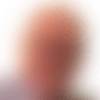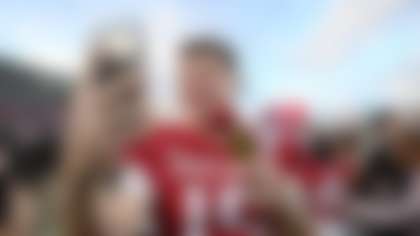Top underclassmen:
» Offense: Quarterbacks | Running backs | Wide receivers/tight ends | Linemen
» Defense: Linemen/linebackers | Defensive backs
Marcus Lattimore
College: South Carolina
Height: 6-0 Weight: 218
Lattimore started his sophomore season strong, rushing for more than 100 yards in four of his first six contests (including 246 yards and three scores against Navy). He suffered a season-ending torn left anterior cruciate ligament against Mississippi State, however, which led to six missed games and a November surgery. Despite his injury, SEC coaches voted him second-team all-conference after the 2011 season, recognizing his playmaking ability.
South Carolina's high school "Mr. Football" in 2009 (after racking up 1,898 rushing yards and 31 touchdowns his senior year) decided to stay in-state for his collegiate football career, and made his presence felt as a true freshman the following fall. After rushing for 1,197 yards and 17 scores, he was named the Freshman of the Year by many media outlets, earned a spot on the Walter Camp All-American second team and was given first-team All-SEC accolades from league coaches. Only Heisman Trophy winner and NFL star back George Rogers ran for more yards in school history (in 1979 and 1980). Three games accounted for a large share of his season totals, though all were in wins over SEC East opponents that helped the Gamecocks win the division (182 yards against Georgia, 184 yards against Tennessee and 212 yards with three TDs at Florida).
Strengths: Lattimore is a taller north-south runner who plays with good lean to plow for yards between the tackles. Possesses vision and quick feet for his size to slide into a rushing lane, and he has the speed to get upfield after finding the hole. Quite effective on zone runs when used in that capacity. Has the wiggle to freeze and elude tacklers to find space. Spins off piles inside and keeps his legs churning to pick up the extra yard. Gets into his routes fluidly out of the backfield and flashes the hands to adjust to poor throws. Good build for pass protection, and is willing to hustle and make contact to keep his quarterback clean.
Weaknesses: Torn left ACL ended his sophomore season. He's not especially thick in the lower body. Powering through NFL tacklers might be more difficult for him, unless he continues to get stronger. Can lose his balance while trying to avoid tacklers in the open field. Must be more consistent in pass-protection technique, whiffing on his punch or going for cut blocks instead of standing up to blitzers.
NFL comparison:Arian Foster
Bottom line: Lattimore presented a nice combination of power, balance and quickness before that torn left ACL ended his sophomore season earlier than expected. Returning to the form he showed as a freshman will prove to NFL teams he can be a bell-cow back worthy of their trust.
Knile Davis
College: Arkansas
Height: 6-0 Weight: 226
Injuries have limited Davis since high school, but when he's healthy, his talent is undeniable. He missed the 2011 season with a broken left ankle suffered in August. This is an unfortunate trend for Davis: He sat out most of his junior and senior years in high school with collarbone and right ankle injuries. He then aggravated the ankle and broke his collarbone in the spring of 2010, but eventually recovered, much to the chagrin of SEC defenses. Senior teammates Dennis Johnson and Ronnie Wingo have talent, so Davis must prove his health to earn carries in a crowded Arkansas backfield. If he avoids injury and shows the same combination of power and speed that intrigued scouts two years ago, however, Davis should carry the load for the Razorbacks and rank among the top prospects at the position.
He only received 33 carries (163 yards, four touchdowns) his freshman year at Fayetteville and averaged just five totes per game in the first month of the 2010 season. Then came injuries to Johnson and receiver Greg Childs, and the floodgates opened; Davis wound up leading the SEC in rushing with 1,322 yards and 13 scores, including a strong 152-yard performance in an upset of LSU. Conference coaches named Davis first-team All-SEC for his accomplishments. Davis' injury last fall interrupted what many thought would be a springboard season into the NFL. Not only was he named a team captain, but he also appeared on nearly everyone's preseason watch list and All-America squad.
Strengths: Davis is a big-bodied north-south runner. Possesses the foot quickness to make the quick cut, and also has the burst and straight-line speed to break off long runs after getting into space. Has a growing lower-body build and runs with enough forward lean to get through arm tackles. Agile enough to spin off tackles inside and hurdle would-be tacklers in the open field. Can use the strength he builds in the weight room to be a physical pass protector, and is aware enough to hit multiple targets. Provides some receiving skills as a check-down option over the middle and can handle good throws in the flat.
Weaknesses: Has a long injury history, missing time in each of the past four years with some sort of malady. Runs a bit top-heavy and gets tripped up easily in space, especially before he gets a head of steam. Inconsistent taking on tacklers at the second level, he will try to run around them instead of using his strength. He's also inconsistent when protecting his quarterback, resorting to (and missing) cut blocks. Lack of hip flexibility hurts his ability to adjust to poor throws as a receiver.
NFL comparison:Corey Dillon
Bottom line: Davis is a bruising back who has struggled with injuries since high school. But as he proved with an impressive late-season surge in 2010, Davis' power and burst in the open field make him tough to stop when all his parts are in working order.
Joseph Randle
College: Oklahoma State
Height: 6-1 Weight: 200
The OSU Cowboys had two first-round picks in the 2012 NFL Draft in quarterback Brandon Weeden (taken 22nd overall by the Cleveland Browns) and wide receiver Justin Blackmon (Jacksonville Jaguars, fifth overall), but Randle was an equal part of the trio that won the inaugural Pony Express Award (created in honor of the famed SMU running back duo of the 1980s, Eric Dickerson and Craig James), which is given to the most productive teammates in college football. Randle isn't explosive enough to qualify as an elite prospect yet, but he can prove he wasn't just a byproduct of the system by using his growing strength and shifty hips to have a big season leading the Cowboys offense -- without the help of Weeden and Blackmon.
The presence of Kendall Hunter limited Randle's carries in 2010, but the true freshman had at least one carry in all 13 games (82 total, for 452 yards and two touchdowns) and finished the year with 37 catches for 427 yards. He stepped into Hunter's shoes admirably as a sophomore, earning second-team All-Big 12 honors with 1,216 rushing yards and 24 touchdowns in spite of Oklahoma State's passing preference; he did not have 20 or more carries in any game after the first month of the season. His 152 yards and four touchdowns helped OSU beat Robert Griffin III and Baylor, and he covered 151 yards in the team's beatdown of the rival Oklahoma Sooners.
Strengths: A productive back in the running and passing game, he has enough straight-line speed to eat up yardage when open lanes present themselves. Shows wiggle in his game once past the line and can get would-be tacklers to lean the wrong way. Seems to fall forward a lot, and is adding weight to his frame each season to get stronger. Attacks targets as a blocker for bubble screens and two-back sets. He also flashes the form and willingness to be an effective pass protector. Solid receiver on screens and over the middle; he has the hands to rein in wayward passes, and his shifty hips make him elusive after the catch. Solid ball security; Randle did not fumble in 251 touches in 2011.
Weaknesses: A taller back, he'll run a bit upright at times coming through the line or in the open field. Receiver-like build makes pushing the pile a chore. He's a one-speed back without elite burst, a second gear or great acceleration in the open field. Must learn to explode from cuts using better lower-half strength. Struggles to anchor against larger defenders in pass protection, and will duck his head and dive at them instead of staying upright.
NFL comparison:Fred Jackson
Bottom line: Randle brings power and a bit of wiggle to the field. If he shows more explosiveness in his game this season, he can join Weeden and Blackmon in the NFL sooner rather than later.
Le'Veon Bell
College: Michigan State
Height: 6-2 Weight: 244
Bell wasn't highly coveted by major programs early in the recruiting process, being offered by hometown Ohio State and others as a safety and nearly going to the MAC to play running back before Michigan State stepped up with their scholarship. But his senior season flourish (1,333 yards, 21 touchdowns) got MSU on his scent, and they've been happy for it ever since. Now he'll just need to explode for the Spartans in a similar way, and NFL teams will jump at the opportunity to add his power and agility in their backfield.
His start as a true freshman was so good that he joined the Doak Walker Award watch list during the season; most of his 605 rushing yards and eight scores came in the first six weeks of the year, before Edwin Baker finished off the year as the lead back. Bell flipped the script on Baker in 2011, however, starting the last six games after coming off the bench over the first eight (182-948, 13 TD; 35-267 receiving). Big Ten coaches named him honorable mention all-conference for his efforts.
Strengths: Big, bruising back with power in his lower body but lighter feet than you'd expect give his size. North-south runner effective in one and two-back sets. Strong cuts and a nice burst out of them makes him capable of breaking off big runs when the hole is available. Sets up defenders in the open field to cut away. Flashes some stop-start ability and shake in space that freezes oncoming defenders. Pushes piles with lower body strength. Can lower his pads for contact, churn through tackle attempts to become difficult to bring down due to second and third efforts. Wiggles and pushes through traffic inside to get the extra yard after it looks as though he's stopped. Possesses a spin move to come off tackles at the second level, maintains balance to keep on moving or at least fall forward for an extra couple of yards. Uses a strong stiff arm in space, as well. Agile enough to jump over defenders trying to cut him down in the open field. Used in Wildcat formation in the red zone.
Weaknesses: Taller back who presents a big target for defenders to hit, especially when failing to lower his pads going into the hole. Size also limits his breakaway speed and ability to create on his own if challenged by better front sevens. Bit of a strider who doesn't always see the cutback lane or avoid penetrating defenders, running up the back of blockers. Pass protection form is inconsistent, has size to handle rushers or at least push them around the pocket, but often moves his feet too slowly or tries to cut instead of setting to anchor. Able to make catches in the flat, but can double-catch at times and must prove he can secure hot passes from NFL quarterbacks. Inconsistent making better cornerbacks miss after the catch. Holds the ball away from his body at times, though he doesn't fumble very often.
NFL comparison:Michael Bush
Bottom line: This powerful but agile back didn't grab recruiting notice until his senior season, but the Spartans were glad they brought him on board when he contributed 605 rushing yards in his first year on campus. His bruising style also came in handy on MSU's way to the Big Ten Championship Game in 2011 (948 yards, 13 TD), and portends a solid NFL career in which he gets tough yards inside as a starter while chugging for big gains if unchecked near the line of scrimmage.
Follow Chad Reuter on Twitter @ChadReuter.




